NevadaToday
The Power of Preservation Preservation as public service, the Washoe County Recorder historical records project
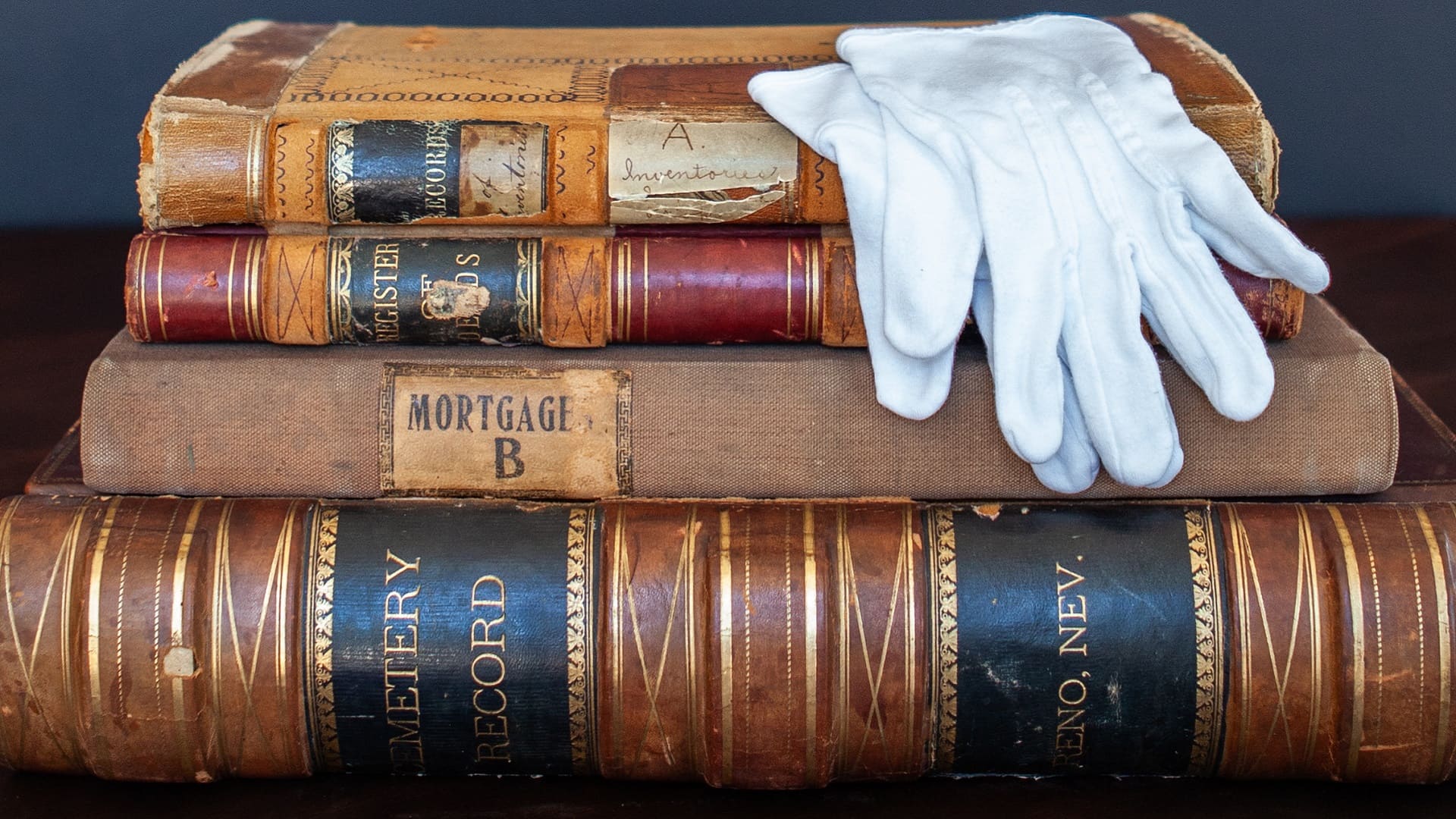
The Power of Preservation
The University Libraries Digital Services Department recently partnered with the Washoe County Recorder’s Office to execute a pilot project in which the Libraries digitized 20 volumes of historically significant records from the Recorder’s Office library of nearly 4,000 volumes. The Recorder’s Office had a desire to create digital copies of records from their library for preservation purposes. The Recorder’s Office was also interested in providing potential users with access to the records online.
Primary source materials digitized by the Libraries for the Recorder’s Office included a variety of official County records, land transactions, homestead claims, land surveys, liens, cemetery plots, court judgments, property claims. Records range from 1855 to 1964, covering the time from when Nevada was part of the Utah Territory, then became the Nevada Territory, and later became a state.
The University Libraries is a physical and virtual hub for preservation both on and off campus.
“As the Department has evolved over the past year we have grown,” Head of Digital Services Nathan Gerth said. “The Department is using its technology, equipment, and platforms to preserve records that lead to diverse and lasting impacts that exist well beyond the Libraries.
“The partnership with the Recorder’s Office is a perfect example of how the Libraries fulfill a critical need for a key player in our community.”
In order to complete the project, the Department worked to design a strategy for how they would go about digitizing the records. They met with the Recorder’s Office team and presented their plan. With the Recorder’s approval, the Libraries team prepared for the arrival of materials.
“I was very impressed by the Digital Services Lab,” Washoe County Recorder Kalie Work said. “The ease of collaborating with the Libraries team was extraordinary. Our materials were well cared for, the student assistants were knowledgeable, and the County was seamlessly incorporated into the work of the Libraries as the team guided us through every step of the project.”
The Libraries received sets of volumes of records from the Recorder’s Office over the course of the project (three months in the spring/summer 2019). As digitization was completed on a set, that set would be returned to the County and a new set of volumes would be given to the Libraries for digitization.
“When selecting volumes of records from our collection to digitize we tried to select books that were of interest to people in Washoe County and Nevada,” Washoe County Recorder’s Office Senior Deputy Recorder Brandy Ellison said. “For example, we decided to have a portion of our cemetery records digitized in the project because these volumes are some of the most requested and used by the public.”
As the volumes came in to the Department, the team analyzed the condition of each volume.
“I was very impressed by the Department’s diligence in preservation,” Washoe County Recorder Kalie Work said. “I felt like I could trust the Libraries’ staff just as I trust my own team to work with our invaluable, historically significant resources.”
“We had to inspect each volume carefully to understand how to properly prepare each page in the volume for digitization,” Libraries Digitization Lab Manager Katherine Dirk said. “For volumes without traditional bindings, for example, we’d have to carefully unlock the binding, remove pages from the volume and take them out of their protective sleeves, lay them flat and use props to get them camera-ready for digitization.”
The Recorder’s Office placed great trust in the team from the Libraries.
“Our County’s history is well preserved at the Recorder’s Office,” Work said. “The goal for this project was to digitize and bring our records online in a way that was true to the original nature of the volumes. We want to help future generations discover and use our materials to do research or to connect important missing links or answer burning questions. The innovative approach taken by the Libraries to help us digitize our records was a key factor when we considered partnering.”
Digitizing the records
Digital Services Department student assistant Taylor Kunze played an instrumental role in digitizing records for this project. Kunze is a junior from Reno studying Human Development and Family Studies at the University. She’s worked in the Department for nearly a year. She works shoulder-to-shoulder with Department faculty and staff.
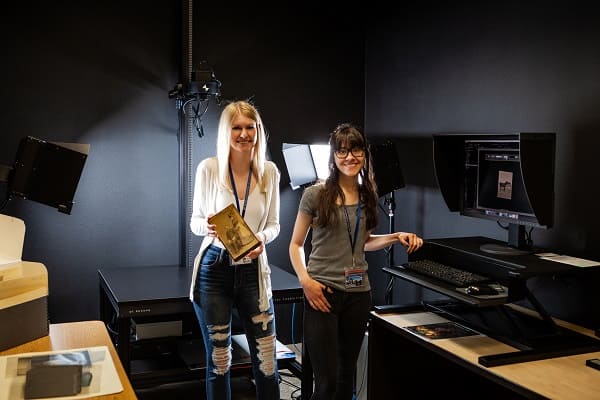
“We see discovery and learning going into each project we take on,” Gerth said. “Our student assistants gain valuable work experience while furthering the Libraries ability to provide access to materials that can assist with the creation of new knowledge and new research. These concepts are part of the Libraries’ core mission.”
Kunze worked to digitize three separate components of the project. She prepared materials for digitization by working with several high-end book scanners and high-end cameras. Kunze also worked to ensure proper calibration of the equipment in order to create a digital surrogate of the record in a way that makes the digital scan of the record look as close to the real thing as possible. In addition to preparing materials for digitization, she assisted with basic post-processing of images and did some transcription work.
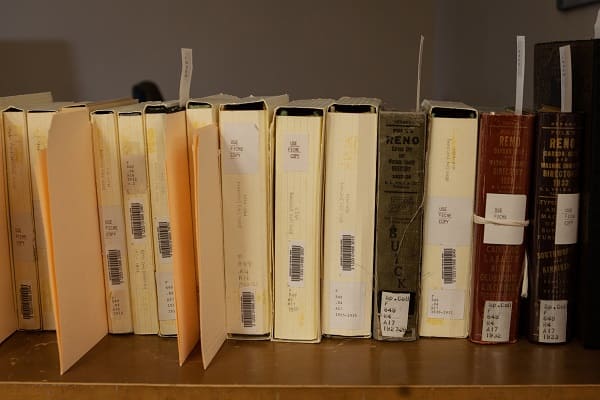
“We worked to capture the true color and texture of the pages, as well as the thickness of the stroke of the script handwriting to give users discovering these materials online the same experience as someone holding the original record,” Kunze said. “I’ve learned so much about software and the technical side of things, but being able to carefully handle these historically significant documents that many people never get to see, that was awesome!”
Kunze said she has benefited tremendously from her work in the Department. She said she feels a deeper and greater sense of connection and belonging to the University community, and plans to put all of the skills she’s gaining on the job to good use when she graduates.
“The most amazing thing about working on this project was being invited to the meetings between the University Libraries and the Recorder’s Office,” she said. “I am planning to go into social work when I graduate, recognizing I will need to understand how large organizations work together. Being invited to meetings for the project was very enlightening. I got to see, first-hand, how these project teams worked together to achieve a common goal.”
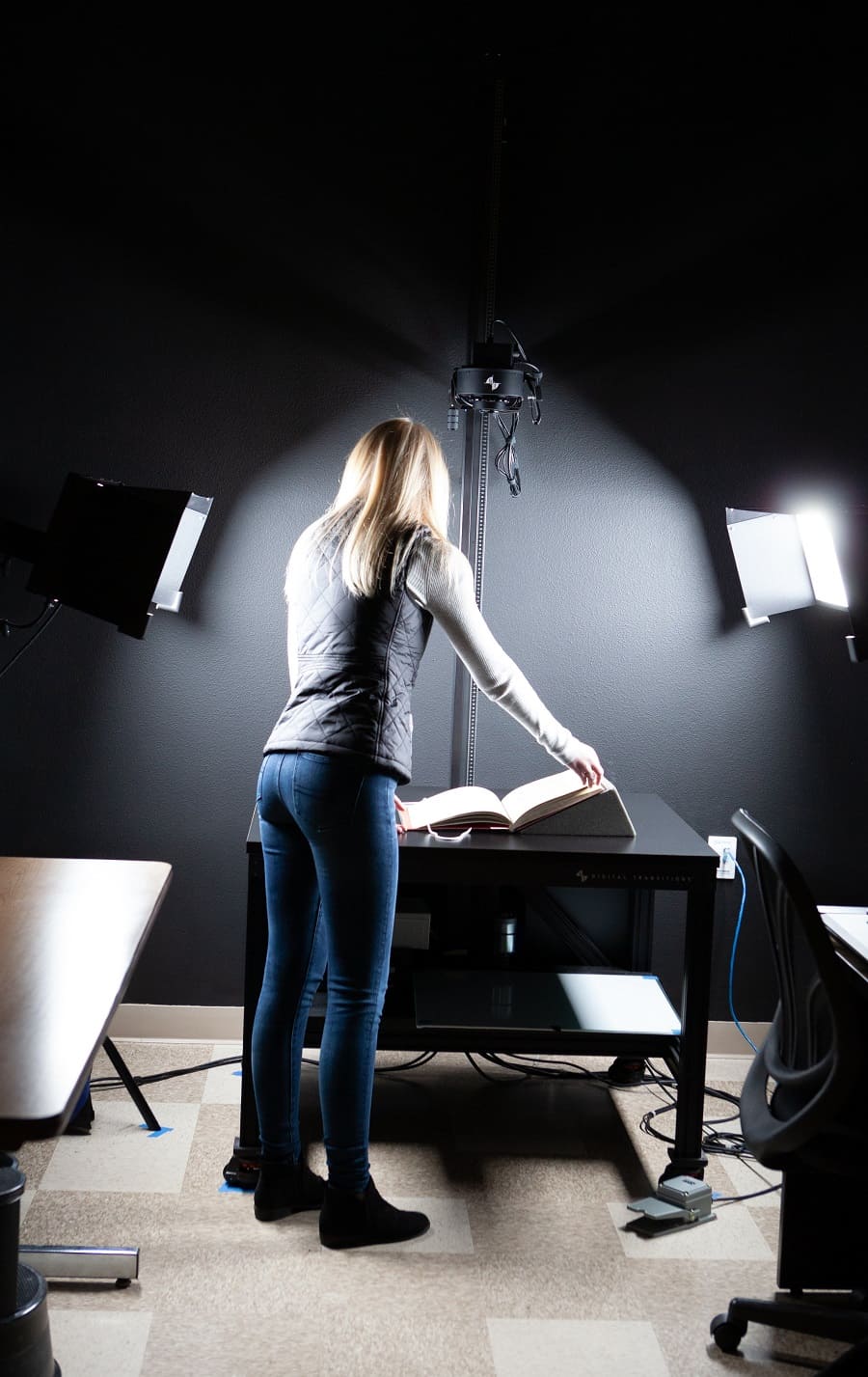
THE PROCESS OF PRESERVATION
1. Physical materials inspected for size and binding type.
2. Volume prepared for digitization. This step includes unlocking and removing pages if in a locked and bound volume.
3. Camera calibrated for digitization. This step ensures proper white balance, focus and lighting.
4. Materials positioned on the scanner. This includes the use props if necessary, including foam supports and bean bag weights.
5. Material digitized
6. Valuable materials returned back to their original location. Materials might be placed back in the locked and bound volume, for example.
7. Post-processing completed. This includes cropping of images and quality control.
8. Metadata created by MCD
9. Digitized images are exported as TIFFs and converted to PDF for inclusion in the University Libraries online repository, Islandora.
10. Final digitized images and metadata are published to Islandora exactly in the same order as it appeared in the original volume.
Local connections
Katherine Dirk, along with Kunze, worked to digitize a few unique volumes of records. For example, the team digitized the Hillside Cemetery Records. This cemetery was established in 1875 after first being named Reno Cemetery in the 1860s. Originally it was one large cemetery. Today, it is divided into four parts: The Hillside Cemetery, Knights of Pythias Cemetery, Grand Army of the Republic Cemetery and the Hebrew Cemetery. It is the oldest established cemetery in Reno, and is home to many prominent local families and individuals. Recognizable Renoites buried here include Edmund Plumb, Frank Orr, Chief Johnson Sides, George Peckham, George Cassidy, Benjamin Leete, and Samuel Rhodes to name a few.
“As I worked to digitize the records I felt a sense of awe and wonder,” Kunze said. “These digitized cemetery records could result in solving a ‘missing link’ for a family, or could assist families in finding other family members who have passed away.”
Dirk also connected with the project. She described the work as “exciting” because it brought her two areas of interest together; history and library science.
“Things have come full-circle with me,” Dirk said. “I used to live on Ralston Street as an undergraduate when I was studying at the University. I walked by the Hillside Cemetery everyday as a student and now I am working on digitizing the records of those resting there now. What a journey!”
While working on the project, Dirk reached out to the Hillside Cemetery Preservation Foundation to let them know that a portion of the cemetery records had been digitized and were now available online.
“The Foundation was very excited to hear we were digitizing these records,” Dirk said. “They shared that many people are planning to use the records for genealogy purposes.”
Other interesting records that were digitized for the County included Records of Inventories, Book A and the Kinsey Records.
Records of Inventories, Book A is a record of property claims. Many records have women’s names attached to them with sentences describing property and things they owned. If one of the women listed in Records of Inventories, Book A divorced her husband, she would be able to keep the things she owned as it had been recorded in this volume of records.
“Working with Records of Inventories, Book A was fascinating to me,” Kunze said. “Seeing what women owned during this particular time in history was interesting. I loved knowing women could keep their property. That was a super progressive way of thinking for that period in history.”
Additionally, while the team was working to digitize a “Miscellaneous Records” volume, they noticed there were a lot of red marks on the pages and some notations had numerical values. The notation that kept occurring was, “From Kinsey’s Records.”
“Not much was known about this volume, and I wanted to get to the context of this notation,” Head of Metadata and Cataloging Emily Boss said. “I had to investigate… Who is ‘Kinsey’ and what are these volumes?”
Boss researched Kinsey in Nevada, Douglas County, and in the Nevada Territory. She discovered that Kinsey was a man named Stephen A. Kinsey.
The Douglas County Recorder’s Office website describes Kinsey as a man who arrived in Carson Valley with Colonel John Reese in 1851. He was appointed clerk of the Probate Court and ex-officio recorder of Carson County on March 3, 1856. He later ran for office and was elected as clerk in 1866 and 1868. In 1857, when the Mormons heeded Brigham Young’s order to return to Salt Lake City Kinsey stayed and was appointed deputy recorder of the area’s valuable property. After a special election in 1858, he was elected Recorder. Later that same year, when vigilantes threatened to destroy county records, Kinsey smuggled them to Salt Lake City for safe keeping until the re-establishment of county government in 1859. Kinsey was one of the first commissioners of the new Douglas County after the Nevada Territory was established. He lived most of his life in Genoa, Nevada, and his home still graces the town square, next to Mormon Station Park.
“It was so exciting to know the Libraries uncovered a really awesome piece of information in our records,” Ellison said. “Knowing the Recorder’s Office was able to contribute to a new discovery, and possibly new avenues for research, is very rewarding.”
Finding the records
In the past anyone wanting to access Recorder’s Office records would have to make a trip to the Washoe County Recorder’s Office and request to see the information in person. Now, thanks to the success of this project and the innovative technology available to the County through the Libraries, anyone can access this select set of records online, from anywhere in the world.
“Maybe someone is interested in learning more about their Nevada roots, maybe it’s to connect to their sense of place or learn more about the name of the street they grew up on,” Gerth said. “Many of these key pieces of information can be found in the records we digitized and placed online in the Libraries online archive for the Recorder’s Office.”
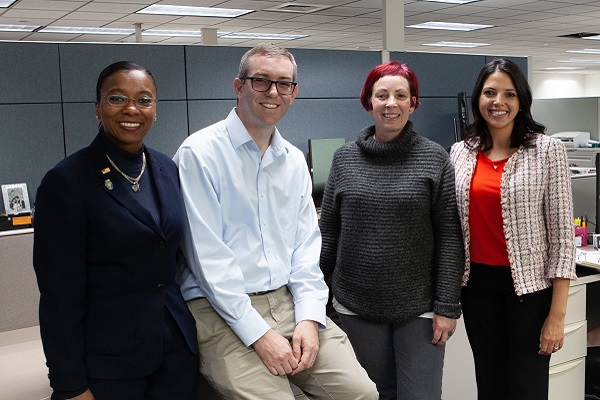
Once all of the County volumes were digitized, the team worked with the Libraries Metadata and Cataloging Department to create metadata to ensure all materials were findable online. It was very important to the County that the Libraries help them put these materials into the public record, online, for users to be able to easily and quickly access the information they are interested in.
“We want people to understand that we have a lot of historical information available through the Recorder’s website,” Hunter Halcomb, Washoe County Recorder’s Office technical specialist said. “The Metadata and Cataloging team at the Libraries helped ensure our records would be accessible and findable by anyone searching the internet for this type of information.”
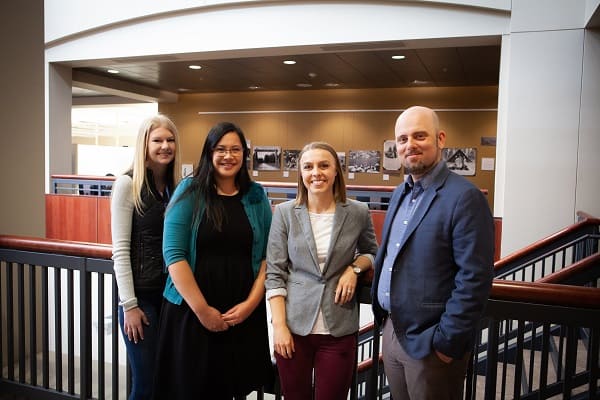
Metadata is a set of data that describes and gives information about other data. It includes language and other information used to describe the records from the Recorder’s Office, indicates what makes a particular record valuable, and also factors in how someone may use a record.
“A good way to think about what metadata is, is to think about how you’d find a book online on the Amazon website,” Boss said. “How do you know if the book you are searching for is the actual book you are being presented in your search findings? What if you are looking for a certain edition or a certain author?
“What matters most in a case like this is how the book you are searching for on Amazon’s website has been described behind-the-scenes, on the backend of Amazon’s website. If the book has been described properly, with the correct key words and terms - good metadata - and you use those same key words and terms in your search to find your book, you will generally be served the book you want. Metadata is magic!”
Boss and her team worked to assign metadata descriptions to every record that was digitized by the Department for the Recorder’s Office. Each record had to be described in great detail in order to make it discoverable, as well as to ensure proper categorization for online access.
“Oftentimes the challenge with metadata is learning that we are essentially speaking to different audiences in different ways,” Gerth said. “The first audience we have to consider is our human audience. The second audience to consider are all of the online search engines that exist. Essentially, we have to let people know these records exist, but we also have to make sure Google can find the data online in search.”
Thanks to the success of this pilot project between the Libraries and the Recorder’s Office the Libraries Digital Services Department is currently in conversation with other community organizations who have similar needs and desires to preserve important materials of value and significance to our community, region, state, and beyond.



